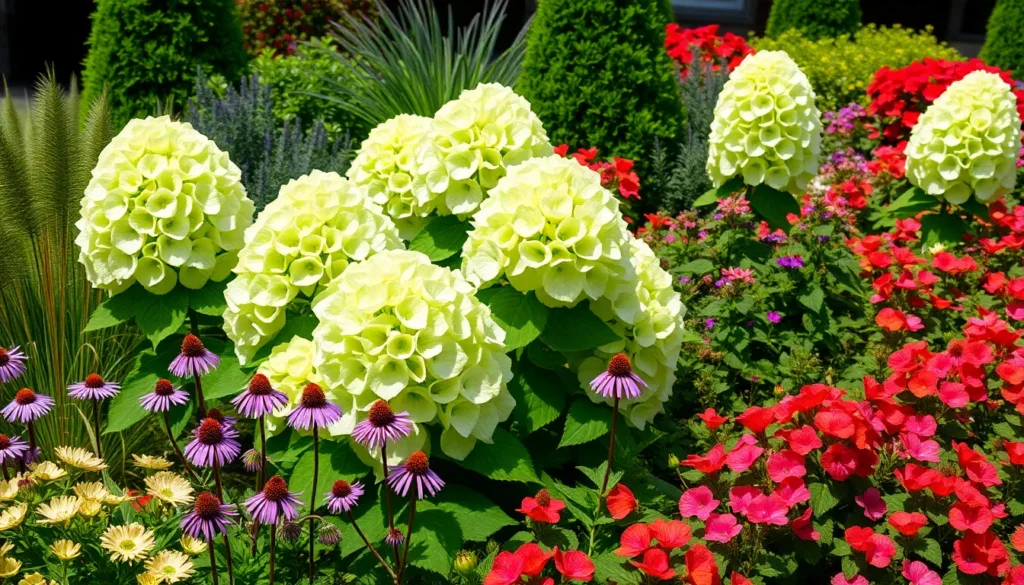We’ve all admired the stunning beauty of Limelight hydrangeas with their massive cone-shaped blooms that transform from creamy white to pink throughout the season. But what truly makes these showstoppers shine? The secret lies in choosing the perfect companion plants that complement their dramatic presence while creating a cohesive garden design.
Strategic companion planting doesn’t just enhance visual appeal – it maximizes your garden’s potential by improving soil health, extending bloom times, and creating natural pest control. When we pair Limelight hydrangeas with the right neighbors, we’re creating a ever-changing network that supports healthy growth and year-round interest.
Whether you’re working with full sun borders or partially shaded areas, we’ll guide you through the best companion plants that thrive alongside these magnificent shrubs. From perennials that echo their color palette to evergreens that provide winter structure, discover how to create stunning combinations that’ll transform your industry into a professional-quality masterpiece.
Understanding Limelight Hydrangea Companion Planting Basics
Successful companion planting requires understanding both your Limelight hydrangea’s needs and those of potential plant partners. We’ll explore the fundamental principles that create thriving garden partnerships.
What Makes a Good Companion Plant
Complementary growing conditions form the foundation of effective companion planting with Limelight hydrangeas. Plants that share similar soil pH preferences (slightly acidic to neutral) work best alongside these stunning shrubs. Water requirements should align closely, as both drought-stressed and waterlogged companions can struggle in mixed plantings.
Height variation creates visual interest without overwhelming your hydrangeas’ dramatic presence. Low-growing perennials like hostas provide ground-level texture, while mid-height companions such as astilbe offer transitional layers. Tall backdrop plants including ornamental grasses frame the composition without competing for light.
Bloom timing coordination extends your garden’s seasonal appeal. Early spring bulbs like daffodils provide color before hydrangeas leaf out, while late-season perennials such as autumn joy sedum carry interest after hydrangea blooms fade. Foliage plants with contrasting textures, including ferns and heuchera, maintain visual appeal throughout the growing season.
Root system compatibility prevents underground competition between plants. Shallow-rooted companions work well with hydrangeas’ fibrous root systems, avoiding conflicts for nutrients and water. Deep-rooted plants like black-eyed Susan can coexist peacefully by accessing different soil layers.
Limelight Hydrangea Growing Requirements
Partial sun to full sun exposure suits Limelight hydrangeas best, requiring at least four to six hours of direct sunlight daily. Morning sun with afternoon shade provides ideal conditions in hot climates, preventing flower burn during peak summer heat. These adaptable shrubs tolerate more sun than many other hydrangea varieties.
Well-draining soil with consistent moisture supports healthy Limelight growth and flowering. Clay soils benefit from organic matter amendments like compost or aged manure to improve drainage. Sandy soils require regular watering and mulching to maintain adequate moisture levels.
Soil pH between 6.0 and 7.0 creates optimal growing conditions for Limelight hydrangeas. Unlike mophead varieties, these panicle hydrangeas don’t change color based on soil pH, maintaining their signature lime green to white to pink progression. Regular soil testing helps maintain proper pH levels for both hydrangeas and their companions.
Space requirements include mature widths of 6 to 8 feet and heights reaching 6 to 10 feet. Proper spacing prevents overcrowding and ensures adequate air circulation around plants. USDA hardiness zones 3 through 9 accommodate Limelight hydrangeas, making them suitable for diverse climate conditions.
Seasonal Considerations for Companion Planting
Spring planting schedules should account for both hydrangea emergence and companion plant growth patterns. Early spring bulbs like crocuses and snowdrops provide color before hydrangeas break dormancy. Cool-season annuals such as pansies offer temporary color until perennial companions establish.
Summer bloom coordination creates continuous garden interest throughout the peak growing season. June through September flowering companions like bee balm and purple coneflower complement Limelight’s extended bloom period. Heat-tolerant plants including Russian sage thrive alongside hydrangeas during hot summer months.
Fall color transitions require planning for post-bloom garden appeal. Autumn-flowering perennials such as asters and mums provide late-season color as hydrangea blooms age to burgundy tones. Ornamental grasses like fountain grass add movement and texture through fall and winter months.
Winter structure becomes important in colder climates where herbaceous perennials die back. Evergreen companions including boxwood and yew maintain garden framework when deciduous plants are dormant. Ornamental bark features from plants like red twig dogwood add winter interest alongside hydrangea’s dried flower heads.
Colorful Perennials That Complement Limelight Hydrangeas
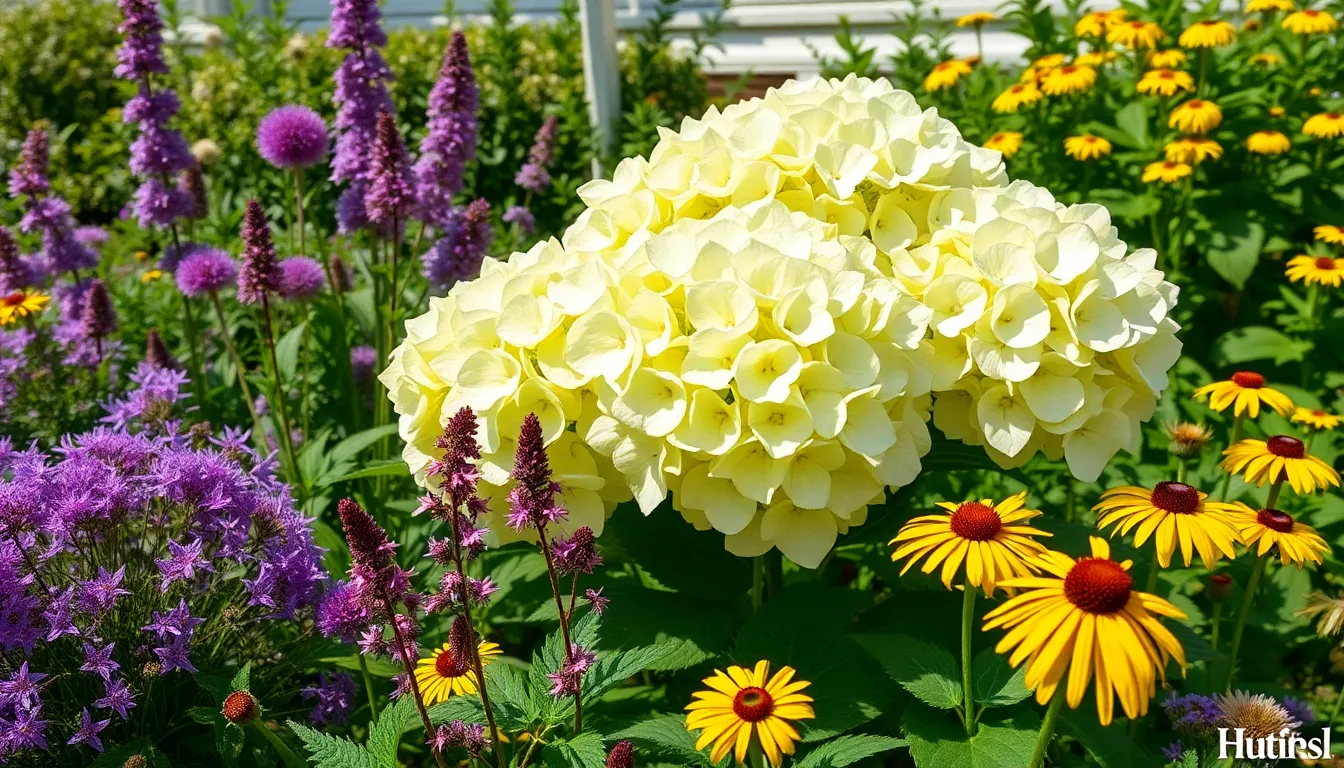
Creating stunning color combinations with Limelight hydrangeas becomes effortless when we select perennials that enhance their unique lime green to pink flower transitions. These companion plants thrive in similar growing conditions while adding diverse textures and seasonal interest.
Purple and Blue Flowering Plants
Alliums transform our garden beds with their tall stems and spherical purple flower heads that create architectural contrast against Limelight’s fluffy panicles. Their vertical structure adds dramatic height while providing bold color contrast that makes both plants stand out beautifully.
Astilbe brings plume-like flowers in purple shades that thrive in the same moist, partly shaded conditions as our hydrangeas. These feathery blooms add texture and depth to plantings while echoing the soft, delicate nature of hydrangea panicles.
Purple Coneflower (Echinacea) delivers deep purple flowerheads that create striking color contrast with Limelight’s pale green blooms. This hardy perennial attracts pollinators while providing long-lasting summer color that complements the hydrangea’s seasonal transitions.
Pink and Red Blooming Companions
Astilbe in red or pink varieties works perfectly to echo the pink tones that develop as Limelight flowers mature throughout the season. These moisture-loving perennials create seamless color harmony while adding textural interest with their feathery plumes.
Coral Bells (Heuchera) contribute foliage colors ranging from deep reds to purples that provide constant color contrast even when not in bloom. Their delicate flower spikes complement hydrangea blooms while their colorful leaves maintain visual interest year-round.
Daylilies offer extensive color options including pinks and reds that add long-lasting floral interest to our hydrangea borders. These reliable perennials provide texture contrast with their grass-like foliage and abundant blooms that extend the flowering season.
White and Yellow Accent Plants
Shasta Daisy (Leucanthemum) produces classic white daisies with bright yellow centers that echo the creamy white stage of Limelight blooms. These cottage garden favorites add cheerful charm while bridging the color transition from lime green to cream.
Black-Eyed Susan (Rudbeckia) brightens our garden with sunny yellow flowers featuring dark centers that harmonize beautifully with hydrangea color changes. These robust perennials bloom throughout summer, providing consistent color when hydrangeas are transitioning.
Golden Hosta (August Moon variety) showcases chartreuse foliage that contrasts dramatically with hydrangea leaves and blooms. This luminous yellow-green accent plant thrives at the base of shrubs, creating stunning color layering in partially shaded areas.
Structural Plants That Enhance Limelight Hydrangea Gardens
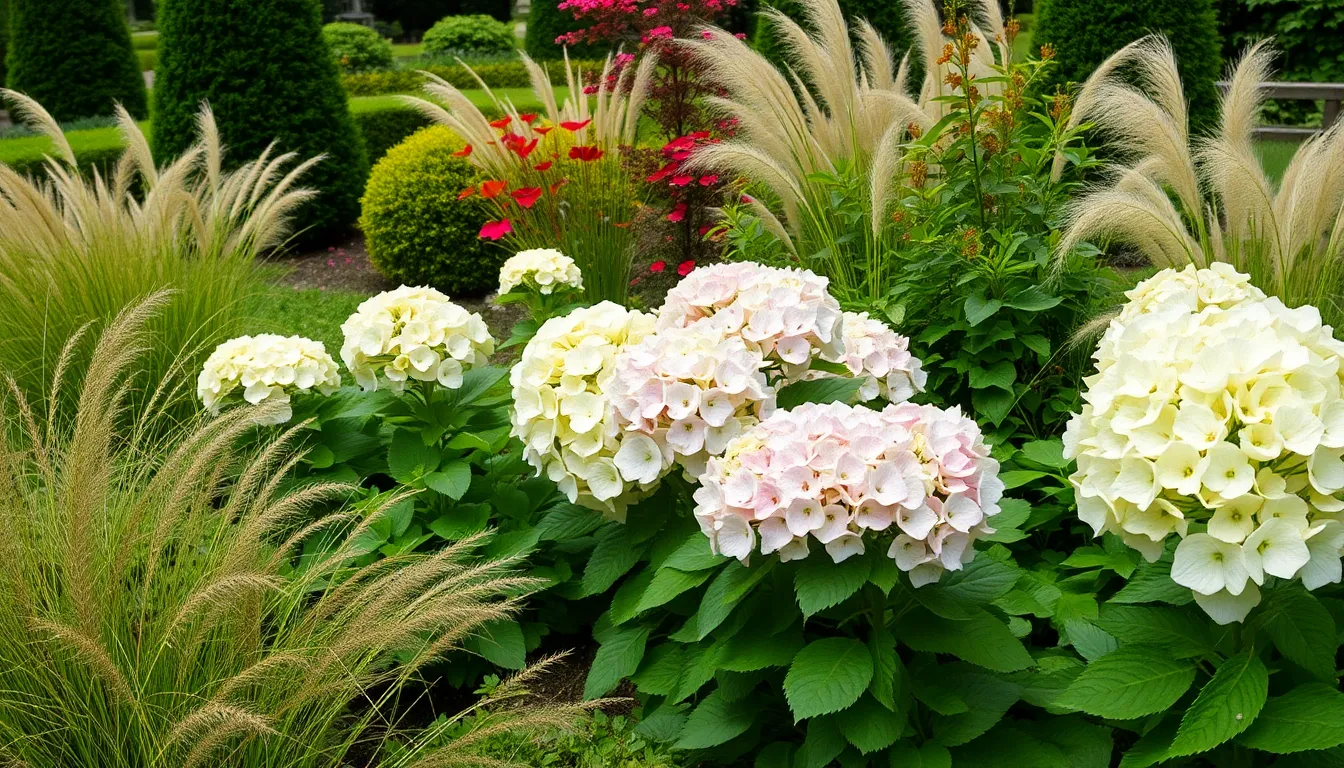
Structural plants form the backbone of any successful hydrangea garden design. We’ll explore three key categories that provide essential framework and year-round appeal alongside your Limelight hydrangeas.
Ornamental Grasses for Texture
Karl Foerster Feather Reed Grass stands out as our top recommendation for adding dramatic texture contrast to Limelight hydrangea plantings. This clump-forming grass develops an upright habit that perfectly fills spaces between hydrangea shrubs while providing vertical interest that complements the broad, billowy blooms.
Ornamental grasses bring movement and fine texture to garden beds, helping break up the lushness of hydrangea flowers throughout the growing season. We particularly appreciate how these grasses maintain their architectural form well into winter, extending visual interest when hydrangeas enter dormancy.
Different grass varieties offer varying heights and textures, allowing us to create layered compositions that enhance rather than compete with Limelight hydrangea’s spectacular flower display. Grasses also provide excellent seasonal transitions, with many varieties developing attractive seed heads and changing colors that echo the hydrangea’s own seasonal transformation.
Evergreen Shrubs for Year-Round Interest
Boxwood varieties deliver unmatched year-round structure with their deep green, compact foliage that creates stunning contrast against Limelight’s chartreuse to white flower progression. These evergreen workhorses thrive in zones 5-9 and adapt well to both sun and partial shade conditions, making them ideal framing plants for beds or pathway borders.
Golden hostas like ‘August Moon’ provide exceptional groundcover beneath hydrangeas while offering attractive chartreuse foliage that perfectly complements the hydrangea’s lime-green blooms. We find these varieties particularly effective for creating layered plantings that maintain interest at multiple levels throughout the garden.
Evergreen hollies and dwarf conifers serve as excellent structural anchors, maintaining greenery during winter months when deciduous companions have shed their leaves. These plants ensure our garden design remains visually appealing year-round, providing the essential backbone that supports seasonal flowering displays.
Small Trees for Vertical Dimension
Dogwoods and Japanese maples represent our preferred choices for adding height and vertical interest to Limelight hydrangea gardens. These small flowering trees thrive in partial shade conditions similar to hydrangeas while offering contrasting branching forms and foliage colors that enhance the overall garden composition.
Multi-stemmed shrubs that can function as small trees provide excellent opportunities for creating tiered plantings without overwhelming the hydrangea’s presence. We recommend selecting varieties that offer seasonal interest through spring flowers, summer foliage, or fall color changes that complement the hydrangea’s own seasonal progression.
Small trees create natural canopy layers that can provide beneficial afternoon shade for hydrangeas in hotter climates while establishing the vertical structure needed for ever-changing garden design. These taller companions also serve as excellent backdrop plants that frame and highlight the hydrangea’s spectacular blooms without competing for attention.
Ground Cover Options for Limelight Hydrangea Beds
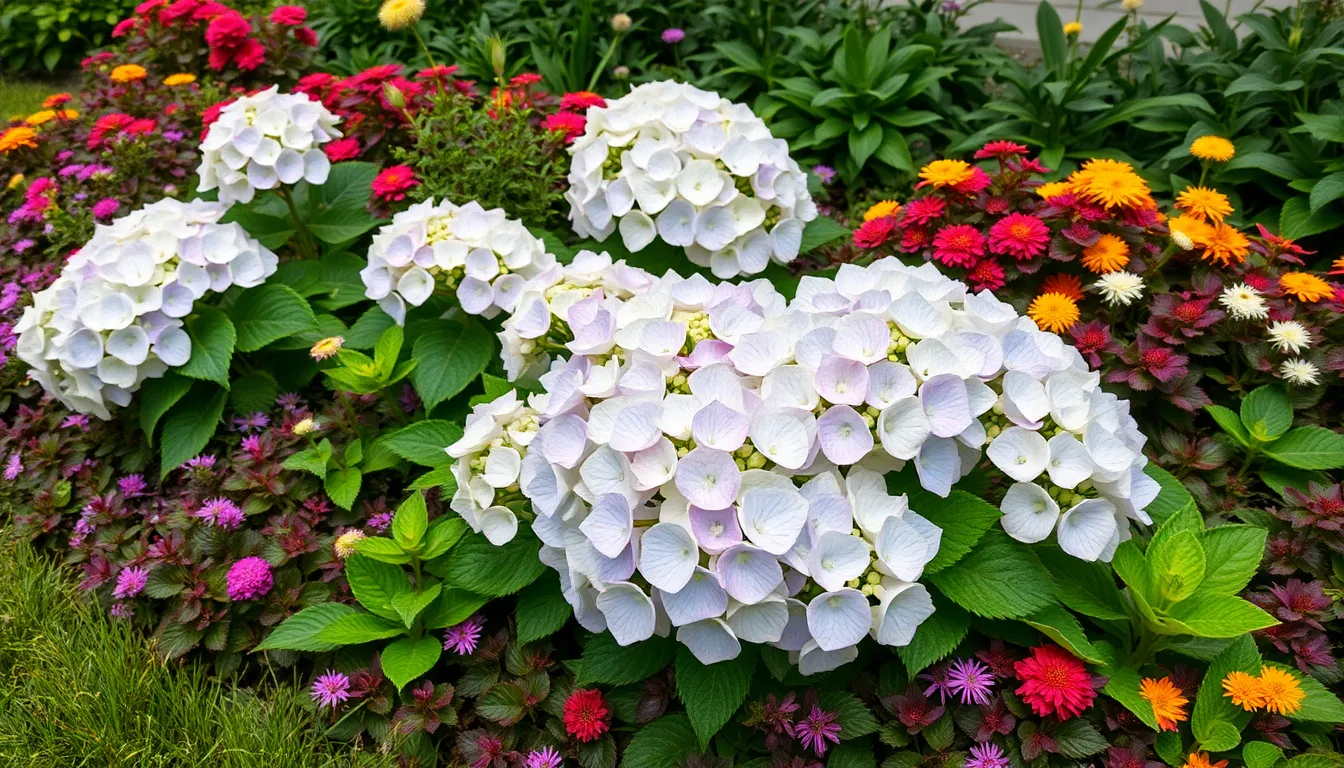
Creating a complete garden design around your Limelight hydrangeas means selecting ground cover plants that’ll enhance their beauty while providing practical benefits. We’ve organized the best options into three categories to help you build a thriving, low maintenance bed.
Low-Growing Perennials
Cranesbill (Geranium) forms dense, spreading mats that naturally suppress weeds beneath your hydrangeas while requiring minimal care. These hardy perennials produce delicate flowers in pink, purple, or white that complement the lime green blooms perfectly. We recommend planting them 12 to 18 inches apart for optimal coverage.
Heuchera (Coral Bells) adds year round interest with colorful foliage in shades of purple, bronze, and green that creates stunning contrast against hydrangea flowers. Their compact growth habit makes them ideal for edging beds or filling spaces between larger plants. Most varieties reach 8 to 12 inches tall and spread slowly to form attractive clumps.
Hostas serve as excellent living mulch with their broad, glossy leaves that shade the soil and retain moisture around hydrangea roots. Varieties like ‘August Moon’ offer golden chartreuse foliage that echoes the lime tones in hydrangea blooms. Plant them 18 to 24 inches apart to allow for their mature spread.
Creeping Plants for Moisture Retention
Creeping Jenny (Lysimachia nummularia) spreads quickly across the ground with its trailing stems and bright green, coin shaped leaves. This fast growing ground cover creates a living carpet that helps retain soil moisture while adding texture variation to your hydrangea bed. We suggest containing it with edging since it can spread aggressively.
Ferns contribute to moisture retention through their lush foliage while adding graceful, airy texture that contrasts beautifully with hydrangea’s bold flower heads. Their dense root systems help maintain humidity around the root zone, creating ideal growing conditions. Popular varieties include Christmas fern and lady fern for their shade tolerance.
Wild Ginger forms dense colonies of heart shaped leaves that create excellent ground coverage in shaded areas beneath hydrangeas. This native perennial thrives in moist, rich soil and helps preserve soil moisture through its spreading habit. Plant it in spring for best establishment results.
Seasonal Annuals for Color Variety
Impatiens provide continuous blooms in shades of pink, red, white, and purple that complement Limelight hydrangea’s color transitions throughout the season. These shade tolerant annuals fill gaps quickly and offer reliable color from spring until the first frost. We recommend spacing them 8 to 12 inches apart for full coverage.
Begonias deliver bold, waxy flowers in vibrant colors that create striking contrast against the softer hydrangea blooms. Their succulent like leaves and compact growth make them perfect for edging or filling small spaces in your ground cover design. Choose shade tolerant varieties for best performance under hydrangeas.
Caladiums offer dramatic foliage in combinations of pink, white, red, and green that add tropical flair to your hydrangea bed during summer months. These heat loving annuals thrive in the filtered shade created by hydrangea canopies. Plant them after soil temperatures reach 70°F for optimal growth and color development.
Foliage Plants That Create Stunning Contrasts
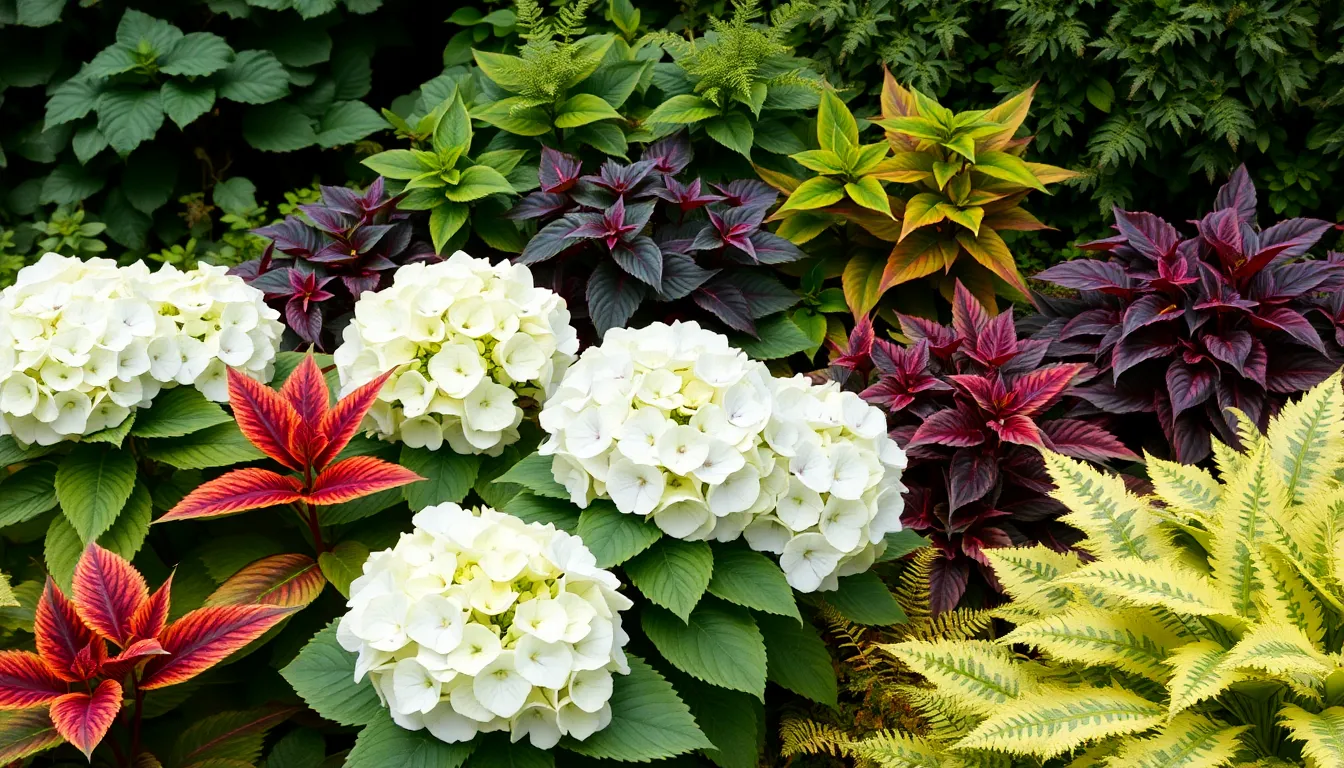
Selecting the right foliage companions transforms your Limelight hydrangea from a standalone beauty into the centerpiece of a ever-changing garden display. We’ll focus on plants that offer dramatic textural differences to make your hydrangeas truly shine.
Bold-Leaved Hostas and Heucheras
Hostas deliver the most dramatic foliage contrast for your Limelight hydrangea with their large, glossy leaves that create stunning visual impact. Chartreuse varieties like ‘August Moon’ hosta provide a striking backdrop that amplifies the lime green tones in your hydrangea’s early blooms. Blue leafed hostas such as ‘Blue Angel’ create cool contrasts against the warm pink tones that develop as flowers mature.
Heucheras offer year-round color variety with their mounded habit and richly colored foliage ranging from deep purple to bright lime green. Purple leafed varieties like ‘Palace Purple’ create dramatic depth beneath your hydrangeas while lighter colored heucheras echo the hydrangea’s changing bloom colors. Their compact size makes them perfect for layering at the base of your shrubs without competing for space.
Positioning these bold plants strategically creates the most effective contrast when you place larger hostas 3-4 feet from your hydrangea base and cluster smaller heucheras closer to the front of the planting bed.
Fine-Textured Ferns and Astilbe
Ferns provide the perfect delicate counterpoint to Limelight hydrangea’s substantial blooms with their intricate fronds that dance in light breezes. Japanese Painted Ferns offer silvery foliage that brightens shaded areas while maintaining the moisture loving conditions your hydrangeas prefer. Their fine texture creates visual breathing room that prevents your garden from feeling too heavy or dense.
Astilbe brings feathery elegance with both its fern like foliage and plume shaped flowers that bloom alongside your hydrangeas in summer. White astilbe varieties complement the early lime green hydrangea blooms while pink and red selections harmonize beautifully with the mature pink tones. These perennials thrive in the same moist, well-drained conditions your hydrangeas love.
Layering these fine textured plants works best when you position ferns in the shadier spots beneath your hydrangeas and place astilbe where they’ll receive morning sun but afternoon protection.
Variegated Plants for Visual Interest
Variegated hostas brighten garden beds by reflecting light and creating focal points that draw attention to your Limelight hydrangea’s spectacular blooms. Varieties like ‘Patriot’ with their white edged leaves or ‘June’ with blue green and yellow patterns add complexity without overwhelming the space. These plants catch morning light and highlight the subtle color changes in your hydrangea flowers throughout the season.
Variegated heucheras extend the color palette with cream, silver, and gold markings that echo the lighter tones in your hydrangea’s evolving blooms. Plants like ‘Marmalade’ heuchera bring orange and yellow tones that complement the pink stages of hydrangea development. Their consistent foliage color provides stability while your hydrangeas transition through their seasonal color changes.
Strategic placement of variegated plants creates the most impact when you use them as accent pieces rather than mass plantings, positioning them where they’ll catch natural light and frame your hydrangeas effectively.
Seasonal Succession Planting With Limelight Hydrangeas
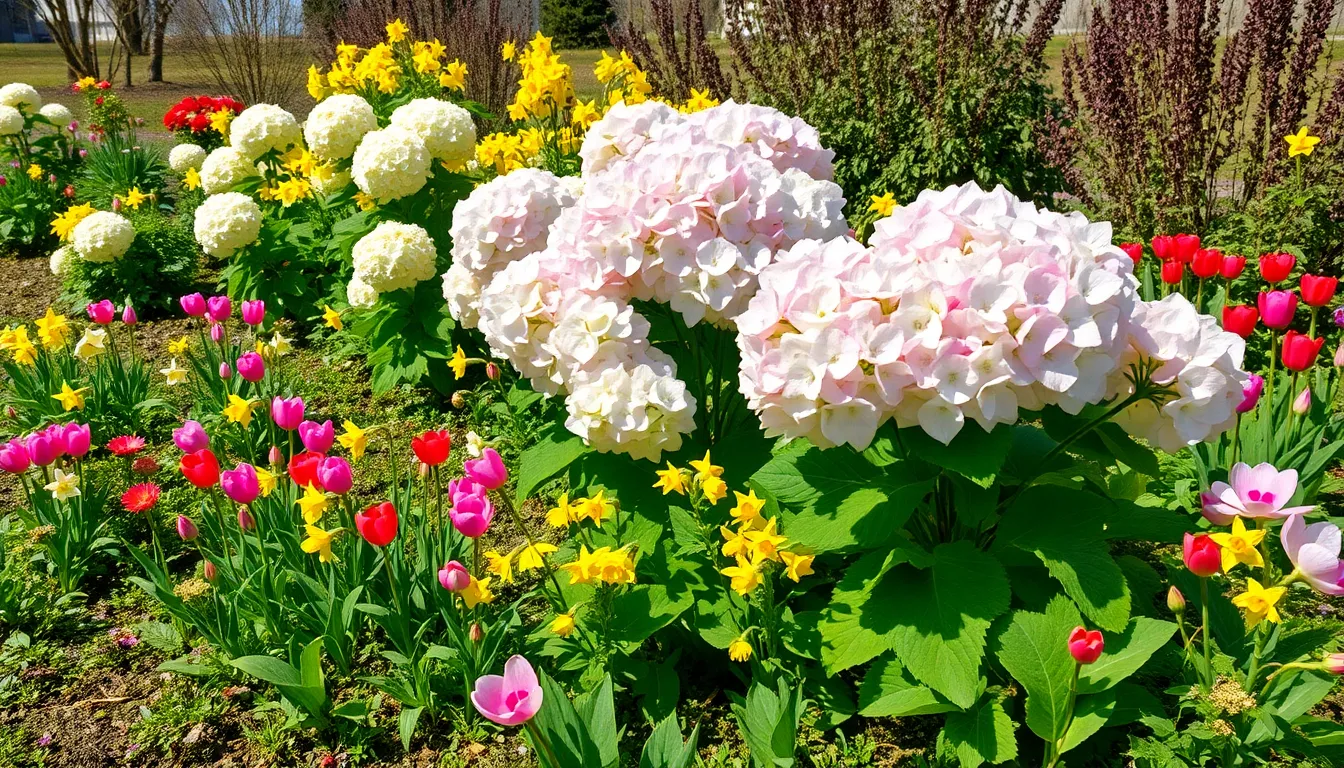
Seasonal succession planting maximizes your garden’s visual impact by coordinating bloom times throughout the growing season. We’ll create continuous color and interest by strategically layering plants that complement Limelight hydrangeas from spring through fall.
Spring Bulbs and Early Bloomers
Early flowering bulbs provide vibrant color before Limelight hydrangeas leaf out completely. Daffodils, tulips, and crocus emerge in early spring when hydrangea branches remain dormant, creating visual interest during the garden’s quiet season. We recommend planting these bulbs in clusters around the base of your hydrangeas for maximum impact.
Ground covers like cranesbill serve dual purposes as natural weed suppressors and textural elements. These hardy perennials spread beneath hydrangeas while adding delicate blooms and attractive foliage throughout spring. Cranesbill varieties thrive in similar soil conditions and won’t compete aggressively with hydrangea root systems.
Early season perennials extend spring interest with complementary growing requirements. Hellebores bloom reliably in partial shade conditions that suit young Limelight hydrangeas perfectly. Bleeding heart adds graceful, heart shaped flowers that create romantic appeal before summer’s bolder blooms take center stage.
Summer Flowering Companions
Astilbe creates perfect partnerships with its fern like foliage and plume shaped flowers. These perennials thrive in partial shade and moist soil conditions, blooming from mid to late summer alongside Limelight hydrangeas. We love how astilbe’s delicate texture contrasts beautifully with hydrangea’s substantial flower panicles.
Alliums offer vertical drama with their tall, globe shaped flower heads. These ornamental onions create striking contrasts against rounded hydrangea blooms while sharing similar sun and soil preferences. Purple varieties like ‘Purple Sensation’ provide color continuity when hydrangea blooms transition from lime green to white.
Russian sage and lavender contribute silvery foliage textures plus delicate summer blooms. Both plants offer color contrast and natural fragrance that enhances the garden experience. Russian sage’s wispy purple flowers complement hydrangea’s bold panicles without overwhelming the composition.
Hostas excel as textural companions, especially chartreuse varieties like ‘August Moon.’ We recommend these shade loving perennials for gardens where Limelight hydrangeas receive partial sun exposure. Their broad leaves create striking foliage contrasts while requiring minimal maintenance.
Black eyed Susans and Shasta daisies establish cottage garden appeal with bright summer flowers. These cheerful perennials bloom prolifically throughout summer, creating informal charm that balances Limelight hydrangeas’ more structured appearance.
Fall Color and Late Season Interest
Limelight hydrangeas themselves provide exceptional fall interest as flower panicles transform from lime green to pink. This natural color progression extends visual appeal well into autumn, making them valuable multi season performers. We appreciate how these changing hues coordinate with fall foliage from surrounding plants.
Boxwood offers evergreen structure that maintains garden form after hydrangea blooms fade. These compact shrubs provide year round backbone while requiring minimal care. Boxwood varieties create defined edges and geometric interest that complement hydrangeas’ more relaxed growth habit.
Ornamental grasses add movement and texture along garden edges throughout fall and winter. Feather reed grass and fountain grass provide vertical elements that sway gracefully in autumn breezes. These grasses maintain attractive seed heads that extend visual interest well beyond the growing season.
Late blooming perennials sustain color when hydrangea flowers begin declining. Sedums produce succulent foliage and autumn blooms that attract beneficial pollinators. Late flowering asters continue the color show with purple, pink, or white daisy like flowers that bridge the gap between summer and winter dormancy.
Plants to Avoid Near Limelight Hydrangeas
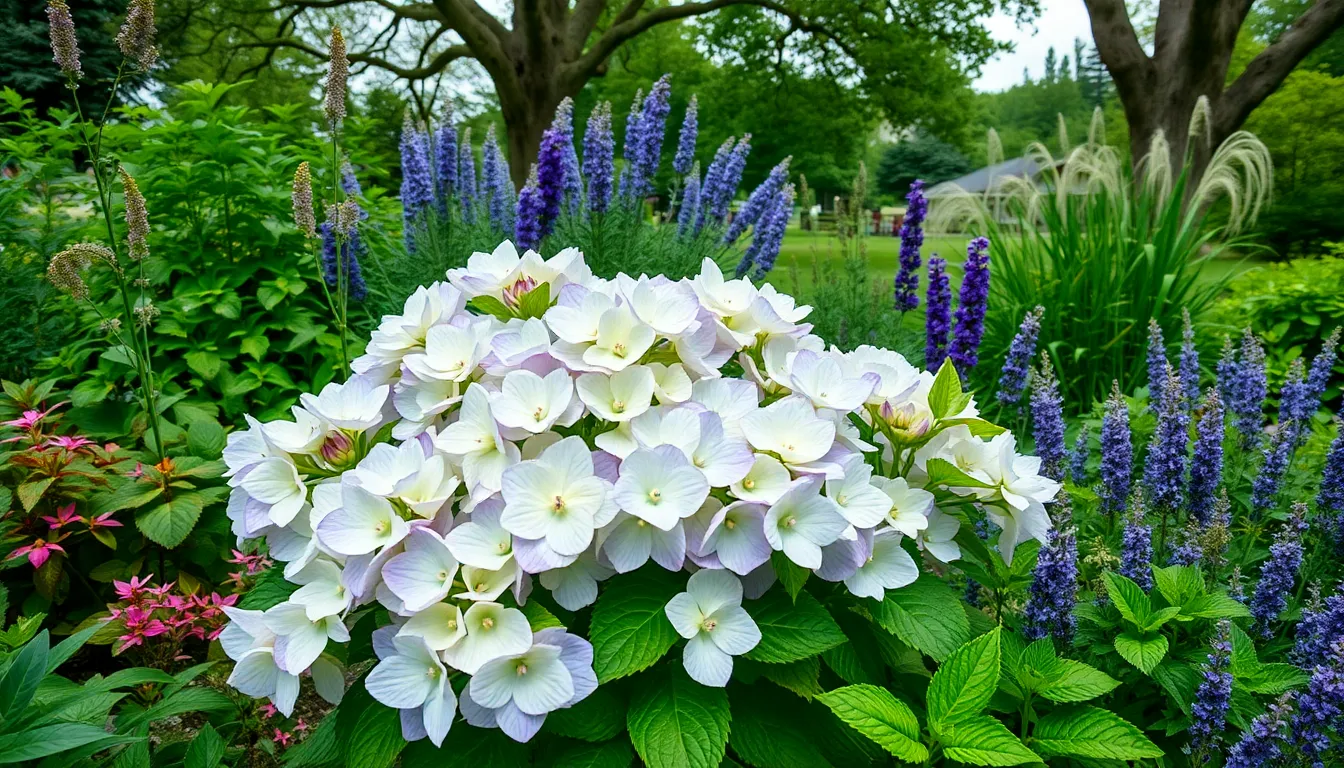
While selecting the right companions enhances your Limelight hydrangea garden, certain plants can actually harm these beautiful shrubs’ growth and flowering potential.
Aggressive Spreaders
Mint varieties create one of the biggest threats to your Limelight hydrangeas because they spread rapidly through underground runners. These invasive herbs quickly overtake garden space and steal essential nutrients that your hydrangeas need for their spectacular blooms. Bamboo species present another serious concern, as their aggressive root systems can spread several feet in a single growing season.
Running types of ornamental grasses like ribbon grass also compete aggressively for territory around your hydrangeas. We’ve seen these spreaders completely dominate planting areas within just two years, leaving hydrangeas stunted and struggling. Goutweed and other invasive ground covers similarly overwhelm nearby plants through their rapid colonization patterns.
Competing Root Systems
Large oak trees pose important challenges for Limelight hydrangeas due to their extensive and deep root networks. These mature trees create intense competition for water and nutrients in the top 12 inches of soil where hydrangeas feed most actively. Maple trees with shallow, fibrous root systems similarly compete directly with your hydrangeas for essential resources.
Black walnut trees present an additional problem through allelopathy, releasing chemicals that inhibit other plants’ growth within their root zone. Dense shrub plantings like large rhododendrons also create root competition while blocking the partial sun exposure that Limelight hydrangeas require. We recommend maintaining at least 6 feet of distance between your hydrangeas and any large woody plants to prevent root system conflicts.
Incompatible Soil Requirements
Desert plants like lavender and sage create problems for Limelight hydrangeas because they prefer dry, well draining conditions while hydrangeas need consistently moist soil. These Mediterranean herbs thrive in alkaline soils with pH levels above 7.0, which prevents proper nutrient uptake in hydrangeas that prefer acidic to neutral conditions between 6.0 and 7.0.
Cacti and succulents demand sandy, nutrient poor soils that directly oppose the rich, organic conditions your hydrangeas need for optimal flowering. Plants requiring high alkalinity like clematis can alter soil chemistry over time, making conditions less favorable for your hydrangeas’ health. Rock garden perennials such as sedum varieties also prefer drought conditions that stress hydrangeas and reduce their impressive bloom production.
Design Tips for Limelight Hydrangea Companion Gardens
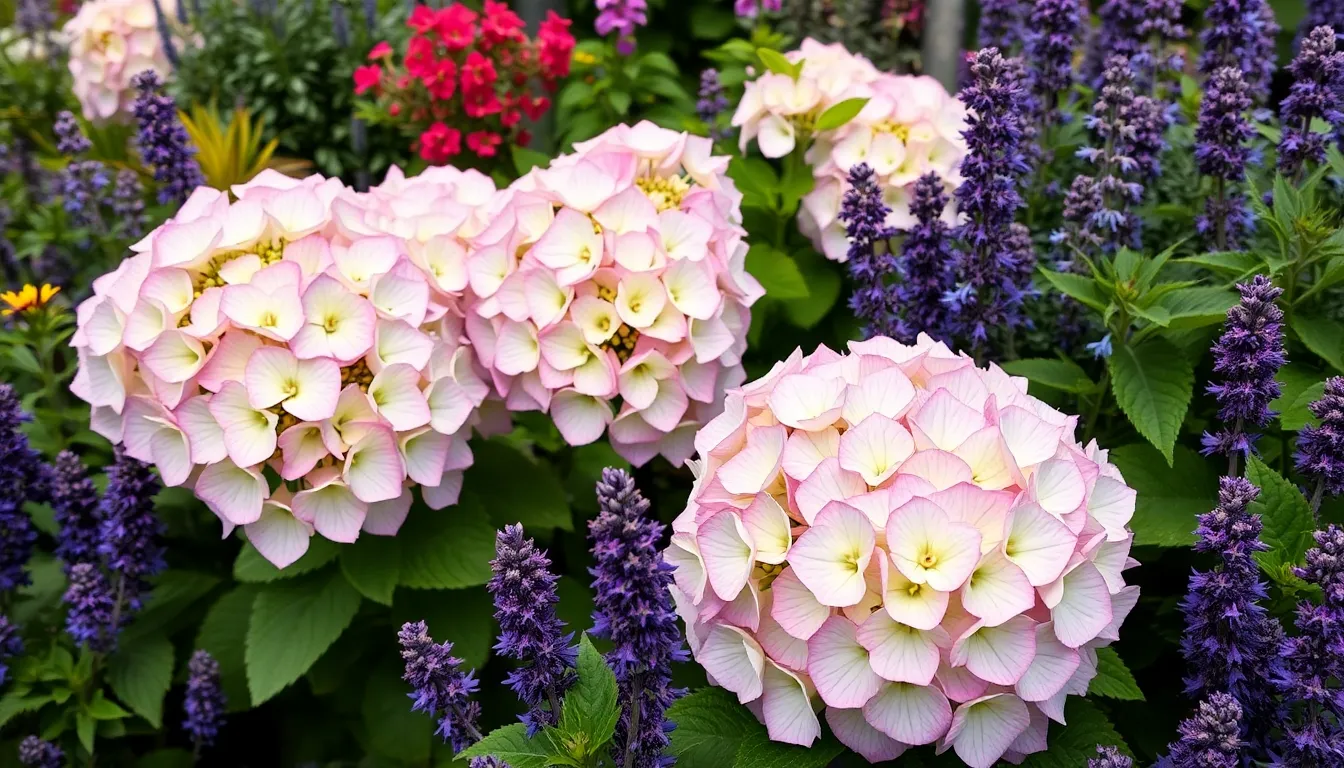
Creating a cohesive design with your Limelight hydrangeas requires strategic planning that considers color harmony, plant placement, and visual flow. We’ll share essential design principles that transform your garden into a stunning industry masterpiece.
Color Scheme Coordination
Contrasting colors create the most striking visual impact when paired with Limelight’s bright chartreuse blooms. Russian sage’s lavender blue flowers and classic lavender’s violet blue tones provide perfect complementary hues that make the hydrangea’s lime green flowers pop dramatically.
Softer color transitions work beautifully for gardeners who prefer subtle elegance over bold contrasts. Astilbe’s pink and white plumes blend harmoniously with Limelight’s color evolution, while cranesbill’s delicate flowers add gentle touches of color beneath the larger shrubs.
Foliage coordination extends your color scheme beyond just flowers, creating year round visual interest. August Moon hostas echo Limelight’s chartreuse tones through their golden foliage, while boxwood’s deep green leaves provide rich backdrop contrast that intensifies the hydrangea’s bright blooms.
Height and Spacing Considerations
Proper spacing becomes crucial since Limelight hydrangeas reach 6 to 8 feet tall and wide at maturity. We recommend planting companions at least 3 to 4 feet away from the hydrangea’s base to prevent overcrowding and ensure adequate airflow for healthy growth.
Layered height arrangements create depth and visual interest throughout your garden beds. Ground covers like cranesbill and hostas work perfectly at the base level, while medium height plants such as astilbe fill the middle layer, and taller companions like Russian sage add vertical drama behind or beside the hydrangeas.
Strategic placement of tall perennials requires careful consideration to avoid blocking sunlight from reaching your hydrangeas. Allium’s globe shaped flowers and Russian sage work best when positioned to receive morning sun while providing afternoon shade protection for more delicate companions.
Creating Focal Points and Flow
Structural elements using boxwood create formal frameworks that naturally guide the eye toward your Limelight hydrangeas as primary focal points. These evergreen shrubs establish permanent garden bones that remain attractive throughout all seasons while highlighting the hydrangea’s seasonal transformations.
Natural flow patterns emerge when you integrate softer plant forms like lavender and astilbe to blur harsh edges between different garden areas. These flowing shapes create smooth transitions that connect various planting zones while maintaining each area’s distinct character and appeal.
Extended seasonal interest develops through strategic bloom time coordination that keeps your garden vibrant from spring through fall. Early blooming lavender provides spring color before hydrangeas emerge, while late season companions maintain visual appeal after the hydrangea’s autumn color show begins to fade.
Maintenance Considerations for Companion Plantings
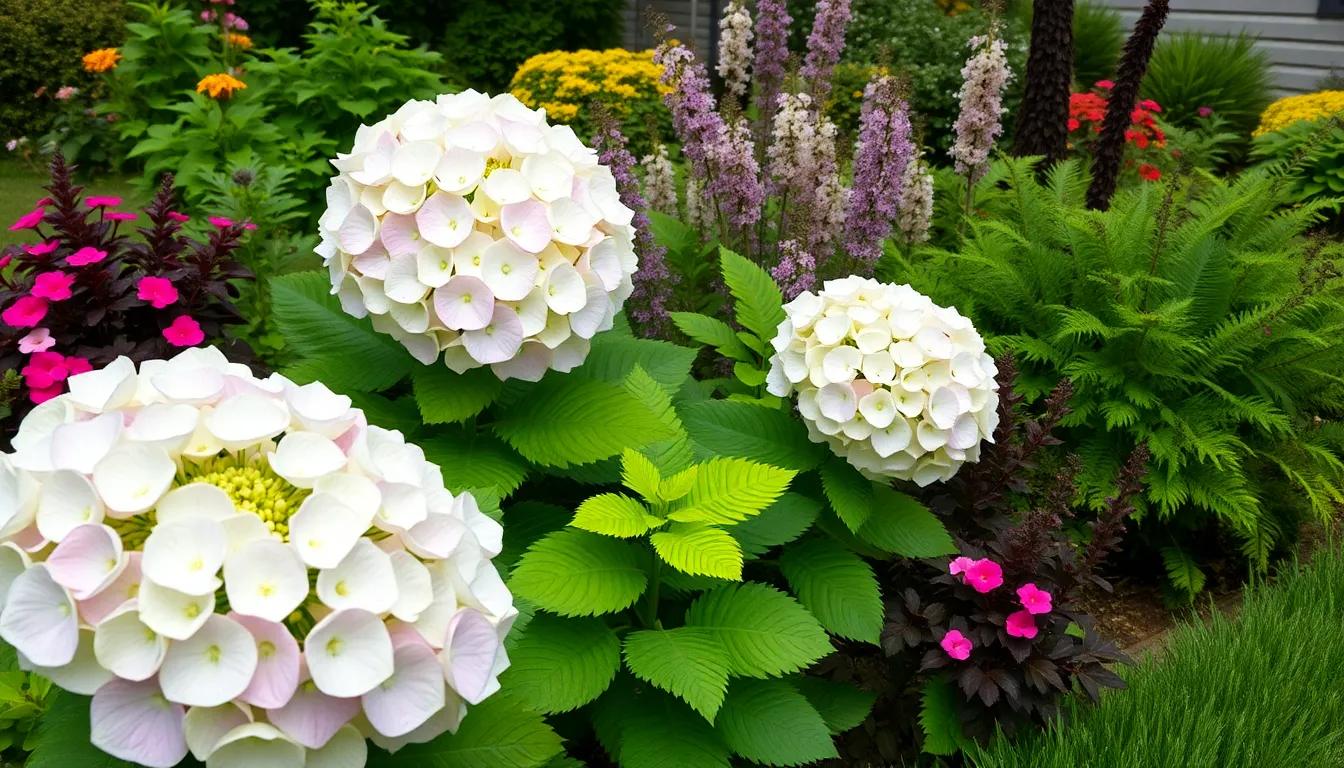
Successfully maintaining a Limelight hydrangea garden with companion plants requires coordinated care that meets each plant’s exact needs. We’ll guide you through the essential maintenance practices that keep your entire garden thriving together.
Watering and Fertilizing Multiple Plants
Grouping plants with similar moisture requirements simplifies our irrigation approach significantly. Limelight hydrangeas and their companions like astilbe and ferns all thrive with consistently moist but well-drained soil conditions.
We recommend establishing a unified watering schedule that delivers deep, infrequent watering sessions rather than frequent shallow applications. Installing drip irrigation or soaker hoses ensures water reaches root zones without creating fungal problems on foliage.
Feeding multiple plant varieties requires a balanced approach that supports diverse nutritional needs. We suggest using slow-release fertilizers designed for shrubs and perennials, applying them according to each plant’s exact growth cycle and requirements.
Spring fertilization works best for most Limelight hydrangea companions, with applications timed before active growth begins. Organic compost amendments provide steady nutrition while improving soil structure for all planted varieties.
Pruning and Deadheading Schedules
Coordinating pruning schedules across different plant types maximizes bloom potential and maintains garden aesthetics. Limelight hydrangeas bloom on new wood, so we prune them in late winter or early spring to encourage robust flowering.
Deadheading companion perennials like astilbe and Shasta daisies extends their bloom time while keeping the garden looking tidy. We remove spent flowers regularly throughout the growing season to promote continuous flowering.
Early spring cleanup involves trimming back hostas and ferns to remove old foliage before new growth emerges. Ornamental grasses benefit from cutting back to 3-4 inches in late winter, allowing fresh growth to develop.
Sequential pruning schedules prevent overwhelming maintenance tasks while ensuring each plant receives attention at optimal times. We create monthly maintenance calendars that outline exact pruning needs for each companion variety.
Pest and Disease Management
Monitoring companion plantings requires vigilant observation for common pests like aphids and spider mites that affect multiple plant types. We treat infestations promptly with insecticidal soap or neem oil applications before problems spread throughout the garden.
Good air circulation prevents fungal diseases like powdery mildew and leaf spot that commonly affect hydrangeas and their companions. We space plants appropriately and avoid overhead watering methods that create moisture on foliage surfaces.
Removing diseased foliage immediately limits disease spread between different plant varieties in the garden. We dispose of infected plant material away from the garden area to prevent recontamination during the growing season.
Preventive treatments work more effectively than reactive measures for maintaining healthy companion plantings. We apply beneficial insect habitat features and companion plants that naturally deter harmful pests while supporting garden network balance.
Conclusion
Creating a stunning garden with Limelight hydrangeas becomes effortless when we choose the right companions. We’ve explored how thoughtful plant selection enhances both beauty and garden health while maintaining the harmonious growing conditions these magnificent shrubs deserve.
The key lies in understanding each plant’s needs and coordinating their care requirements. From colorful perennials to structural evergreens we can build layered landscapes that provide year-round interest and support our hydrangeas’ natural growth patterns.
Remember that successful companion planting isn’t just about aesthetics—it’s about creating a thriving network. When we avoid problematic plants and focus on compatible partners we ensure our Limelight hydrangeas reach their full potential while contributing to a garden that’s both beautiful and sustainable for years to come.
Frequently Asked Questions
What are the best companion plants for Limelight hydrangeas?
The best companion plants include colorful perennials like Alliums, Astilbe, Purple Coneflower, and Coral Bells. Ornamental grasses such as Karl Foerster Feather Reed Grass add texture, while evergreen shrubs like boxwood provide year-round structure. Hostas and ferns offer excellent foliage contrast, and ground covers like Heuchera complete the look.
What growing conditions do Limelight hydrangeas need?
Limelight hydrangeas thrive in partial to full sun with well-draining soil and specific pH requirements. They prefer consistent moisture without waterlogged conditions. When selecting companion plants, choose varieties that share these same growing preferences to ensure all plants flourish together in your garden design.
Which plants should I avoid planting near Limelight hydrangeas?
Avoid aggressive spreaders like mint and bamboo that compete for nutrients. Large trees such as oaks and black walnuts create harmful root competition. Plants with incompatible soil requirements, like desert herbs and cacti that prefer dry conditions, should also be avoided as they thrive in conditions detrimental to hydrangeas.
How do I create good color combinations with Limelight hydrangeas?
Focus on complementary colors that enhance the hydrangeas’ seasonal color changes. Use contrasting colors like lavender-blue Russian sage for drama, or softer transitions with pink Astilbe. White flowers like Shasta Daisies and yellow Black-Eyed Susans beautifully accent the hydrangeas’ cream-to-pink transformation throughout the growing season.
What ground cover options work well with Limelight hydrangeas?
Excellent ground cover choices include low-growing perennials like Cranesbill and Heuchera, moisture-retaining creeping plants such as Creeping Jenny and ferns, and seasonal annuals like Impatiens and Begonias. These options provide practical benefits while adding visual interest and helping maintain soil moisture around your hydrangeas.
How do I maintain companion plantings with Limelight hydrangeas?
Coordinate care by establishing unified watering schedules and using slow-release fertilizers that benefit all plants. Follow proper pruning and deadheading schedules to maximize blooms. Implement preventive pest and disease management practices, and ensure good garden hygiene to support a healthy ecosystem for both hydrangeas and their companions.
What structural plants enhance Limelight hydrangea gardens?
Ornamental grasses like Karl Foerster Feather Reed Grass provide movement and texture. Evergreen shrubs such as boxwood varieties offer year-round structure and framing. Small trees like dogwoods and Japanese maples add vertical dimension and seasonal interest, creating layered garden designs that support hydrangeas without overwhelming them.
How can I extend the blooming season in my hydrangea garden?
Practice seasonal succession planting by coordinating bloom times from spring through fall. Start with early bulbs like daffodils and tulips, add summer companions like Astilbe and Alliums, then incorporate late-blooming perennials such as sedums and asters. This strategy ensures continuous color and visual interest throughout the growing season.

